Where to Stay in London: A Complete Guide for First Timers
When we started planning a two week trip to London, the first thing we dove into was where to stay in London. Pretty quickly, we realized two things.
First, London is massive! Similar to Paris, it’s hard to understand just how big London is until you get there and find yourself saying things like “yeah that’s totally walkable” before putting it into Google Maps and realizing it’s an hour away. We most recently lived in San Francisco, which is miniscule in comparison.
Second, where you decide to stay is going to shape the rest of your trip. Staying in the hustle and bustle of a place like the West End is going to feel very, very different than saying in, say, Hackney, which is much more residential and low key.
Ultimately, we decided to stay in three different areas over the course of our trip, and it confirmed both of those two things. Staying in Southbank felt like a completely different city than staying in Camden!
In this guide, we’re going to do our best to use our experiences and research to help you decide on the best place to stay in London for your particular style, budget, and preferences. Whether you’re looking for a budget-friendly stay (to the extent that those even exist in London, which is a very expensive city to visit), or you’re looking for a splurge, we’ll try to help you find the right place for you.
In the guide below, you’re going to find all the information you need to decide where to stay for your trip to London. We’ll start with our personal experience and where we stayed for our trip, then move on to six great neighborhoods. For each neighborhood, we’ll give you pros and cons, neighborhood highlights, and some places to stay that stood out to us for one reason or another.
Ultimately, the goal is to help you narrow in on which area makes the most sense for your needs.
Sound good to you? Let’s get into it!
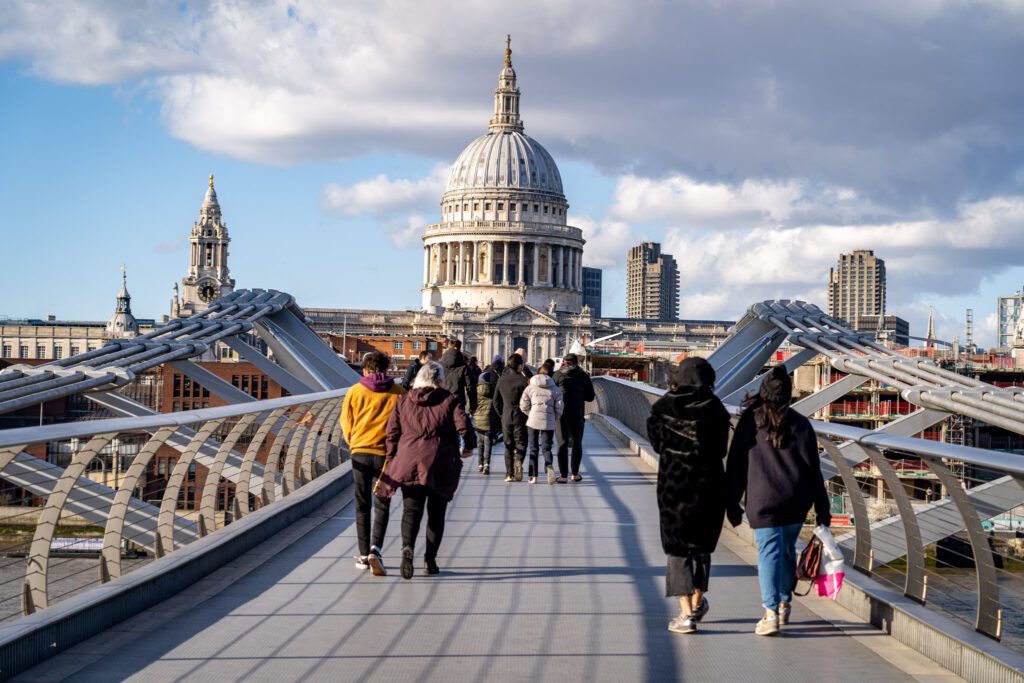

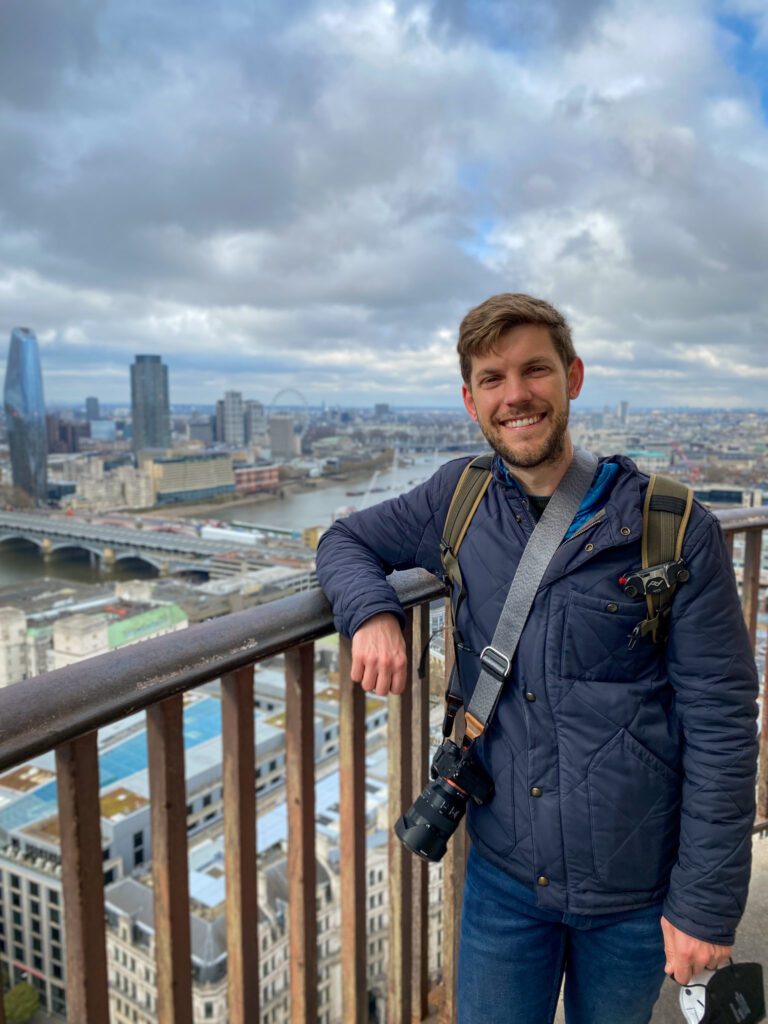
Disclaimer: Some of the links in this post, like hotel links, are affiliate links, meaning at no additional cost to you, we make a little bit of money if you click through and book. That being said, we would never recommend something to you that we don’t stand behind 100%.
Where to Stay in London: 6 Great Places to Stay for First Timers
Before we jump into the specific places to stay in London, we have a few general thoughts on choosing a place to stay.
We’re strong believers that the best way to do it is to first pick the neighborhood you want to stay in, then pick a place within that neighborhood. That’s what you’ll see below – we’ve organized this guide to first cover the neighborhoods, then recommend some cool places to stay within each neighborhood.
Don’t have time to read the entire guide? Here’s a quick summary.
- If you’re looking for a central location and great food and drinks, stay in Southbank. This is our top pick for basically everyone. We spent our first four days in London here, and it was a great location both for exploring the rest of Central London, and for eating and drinking in its own right (psst – skip the restaurants along the river). This is an upscale part of town with modern high rises and fancy office buildings. We stayed at the CitizenM Bankside, which is our favorite hotel chain in the world and this location was their first in London. There are two splurge-worthy hotels in the area – the Hoxton and Sea Containers – the latter of which has dazzling views from some of the rooms right above the banks of the Thames.
- If you want to stay in the middle of all the action, stay in Covent Garden. It’s touristy, sure, but the central location and great public transportation connections will make getting around London a breeze. Plus, it’s full of great bars, restaurants, coffee shops, and shopping.
- If you’re looking for something more offbeat and hip, look north east to Shoreditch, which is a place that made us feel very old and uncool. Lots of vintage stores, hipster coffee shops, nightlife, and great street art in this gentrifying (gentrified?) area. There’s another CitizenM location here, which is where we were set to stay before we decided to stay up in Camden instead.
Where We Stayed in London
It makes the most sense to start this guide with our own experience staying in London.
We were in London for just about two weeks on our last trip – our first in over a decade (for Alysha, since she was five years old) – and decided that because London is enormous, we wanted to stay in three different areas to get a feel for the different parts of the city.
Those three areas – which you’ll find in-depth dives into below – were Southbank, Camden, and the City of London (near the Tower of London).
In Southbank, we stayed at the Citizenm Bankside, which is a great, relatively affordable (relatively in the sense that nothing in London is truly affordable) home base for exploring most of Central London. CitizenM is our favorite hotel chain in the world.

For more on why, you can read about our stay in Seattle here, which is remarkably similar to our stay in London. Almost as if they designed it so that no matter which of their hotels you stay in, the experience is consistent.
Their whole schtick is that the rooms are small, and do one thing really, really well – they provide a great night of sleep with blackout curtains, soundproofing, and huge super comfortable beds. The things that you might find in a different hotel room – a coffee maker, an iron, and other things of that nature – are moved into common areas so that they can keep the cost of the rooms down.
Overall, we’d highly recommend it. They have two other locations in London – one near the Tower of London, and one in Shoreditch – which would also be good options in slightly different neighborhoods.
The second place we stayed was Camden, which we kind of thought would be a more sleepy part of the city, with a more suburb-y feel, but was absolutely not and was just as raucous as most of Central London with a decidedly younger (and hipper) crowd. We needed to get some work done while we were in London, so we opted for an apartment with tons of room to spread out.
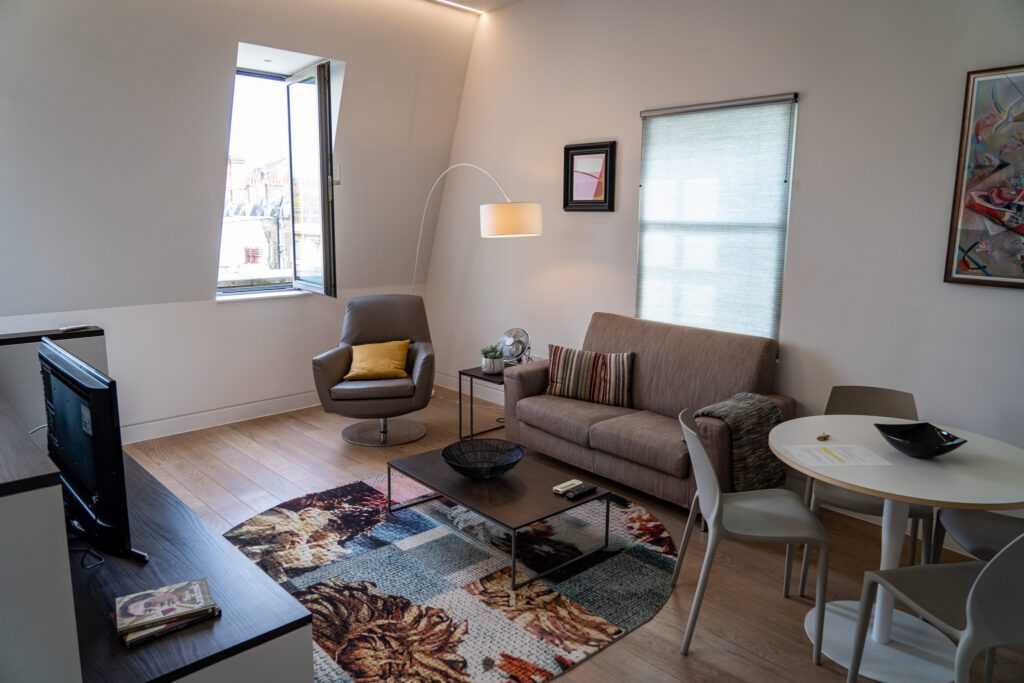
We went with Mirabilis Apartments, and would recommend it based on the location (one block to the Tube, 5-10 minutes to both King’s Cross and Camden Market) and the apartments themselves. We slept great, had a full kitchen, and the apartment was pretty spacious considering it’s London.
The last place we stayed in London was in the City of London, which is the old town of London on the site of the original Roman city. You’d never know it though because many of the buildings burned down in the 17th Century and were bombed during World War 2, so many of the buildings here are very modern.
This is essentially London’s Financial District, and the location right on the Thames with access to the Tower of London, Tower Bridge, and St. Paul’s Cathedral is fantastic. The downside is that, because the neighborhood is full of offices, many of the businesses are closed on the weekends (though not all).
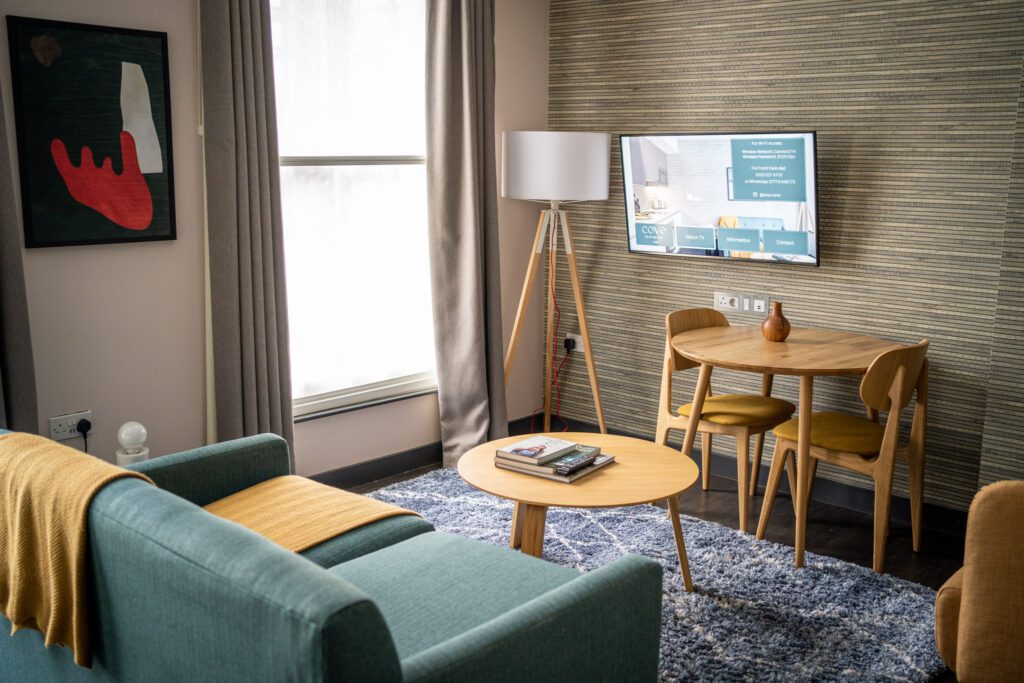
We wanted an apartment here too, so we booked one at COVE Cannon Street, which is kind of like a hotel in terms of the check-in process and 24 hour reception (you can leave your bags!), but the rooms have kitchens and significantly more space.
We liked it, and we walked to Tower Bridge, St. Paul’s, and Spitalfields Market from here.
Southbank & Bankside: Our Top Pick in London (Where We Stayed)
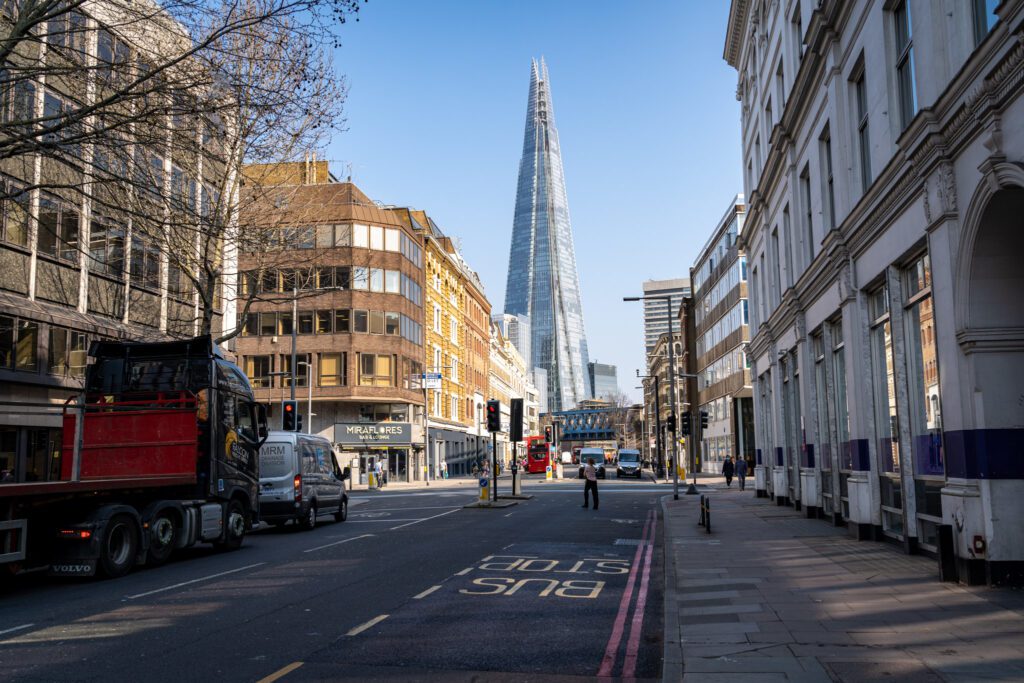
We split up our time in London so that we had four days in three different areas. We chose to do that for two reasons. First, London is massive, and moving around to be more central to a certain part of the city would cut down on travel time. Second, we like experiencing different sides of a city, and staying in a couple of different places gave us the opportunity to do just that.
We spent our first four days in London staying in Southbank, and we absolutely loved it.
We’re technically combining a few different areas here – Southbank, Bankside, and Southwark – what we’re trying to say is that staying anywhere along this stretch between Westminster Bridge and Tower Bridge is an excellent location for exploring London.
First of all, the location along the south bank (hence the name) of the Thames River is amazing. Over the course of your London itinerary, you should definitely make sure to walk the entire stretch from Tower Bridge to Westminster Bridge.
Second of all, it’s easy to get to basically every part of Central London, and there are plenty of amazing places to visit within the neighborhood (looking at you, Borough Market).
Basically, it’s central, packed with bars and restaurants, and is home to our favorite walk in London. What’s not to love?
Well, it’s very modern and, for lack of a better word, techy. Coming from San Francisco, where we basically invented techy, there were definitely times where we’d walk by a group of tech employees in Southbank and do a double take, thinking “wait, are we really in London?”
Still, we definitely think the pros outweigh that con, and would highly recommend it for most travelers.
Pros and Cons of Staying in Southbank / Bankside
Pros
- It’s central. Being close to the river is a nice amenity, and Southbank has that going for it. You’ll be able to walk to places across the river like the Tower of London and Westminster Abbey.
- It’s well-connected. For those places that aren’t walkable, you’ll be well-connected via public transportation to the rest of the city between buses and the Tube, which has helpful stops at Waterloo Station, Southwark, and the Tower of London.
Cons
- It’s a little sterile. Unfortunately, parts of the south bank of the Thames have become almost identical to other major cities around the world with modern skyscrapers, specialty coffee shops, and more.
- It’s pricey. I mean, London is expensive in general, but some of the places in this area are outrageously expensive. But, they also come with river and skyline views, so I suppose that’s part of the reason why. There are a few affordable spots that we’ll get into below.
Southbank Highlights
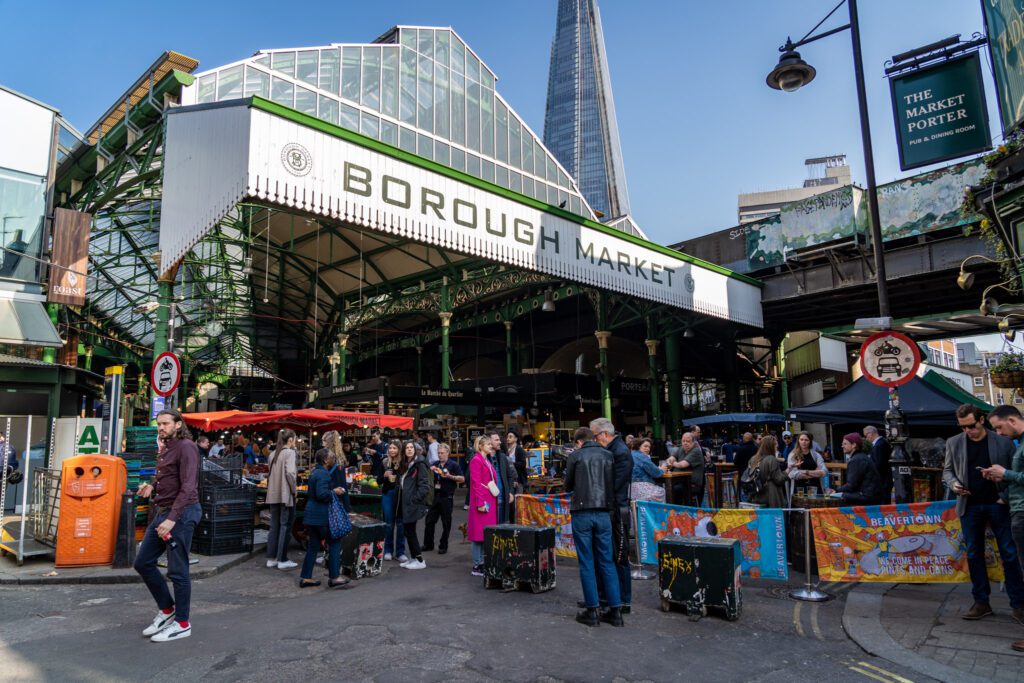
Here are some things not to miss on the south bank of the Thames.
Borough Market: We tried to make it to just about all of the various outdoor food markets we could find in London, and this is definitely our favorite. It’s half food stalls with ready-to-eat meals, half specialty shops like English cheese, Spanish grocery stores, and Italian wine shops. In particular, we love Horn Ok Please (both the chai and the dosas), Black Pig (amazing sandwiches – NOT gluten free), and Monmouth Coffee.
The Tate Modern: A modern art museum that is free to enter (though a donation is recommended to support them and all they’re doing!). Even if you’re not into modern art (guilty!), it’s worth a stop. The best part about cheap museum entry is that you don’t feel like you HAVE to spend hours wandering until your eyes are glazed over. They have a viewing platform on the 10th floor with excellent views of the city (and St. Paul’s Cathedral across the Thames), but it has been closed recently – check here to see if it’s open.
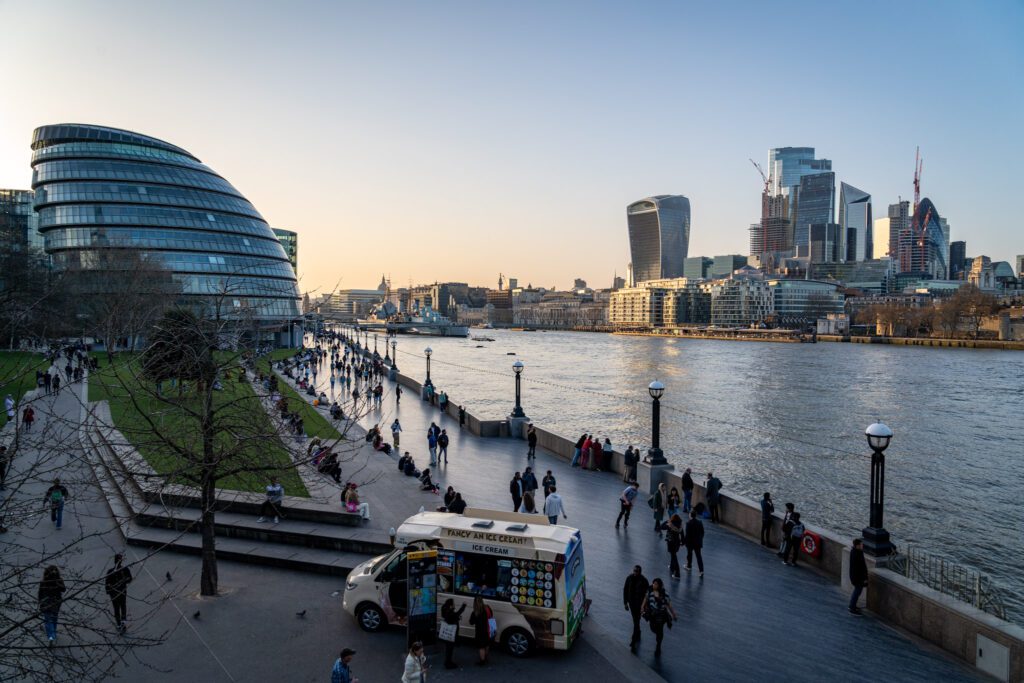
The Walk from Westminster Bridge to Tower Bridge: This is worth an entire half day, because there’s so much to do and see along the way. Start from one end and meander your way to the other, stopping for photos, lunch at Borough Market, and the Tate for a quick break from walking. We’d do this walk in the mid-morning, starting from Westminster Bridge, so you can hit the market for lunch.
The Globe Theatre: I so, so want to see a show at the Globe Theatre on the banks of the Thames, which has been created to look like Shakespeare’s iconic venue. They focus on mainly works of Shakespeare, some with a little bit of a fun twist. Check here to see what’s on when you’re in town.
Origin Coffee Roasters: One of the best coffee shops in London, this outpost from the famous roaster in Cornwall is under the railway line is right near the Southwark Tube station. Get single origin coffees prepared as either espresso or filter from friendly baristas.
Hawkes Cidery: We loved this place. The people were super friendly, the cider is amazing, and it’s right there in Central London, blocks from Tower Bridge. It’s a great place to dive into the world of English cider, and they have a few guest taps in addition to their own ciders on draft to bring in some other companies doing fun things with apples and pears.
The Best Places to Stay in Southbank / Bankside
Here are some places to stay in the area that caught our eye, including where we spent our first four nights in London.
CitizenM Bankside (Where We Stayed): The Best Mid-Range Hotel in London
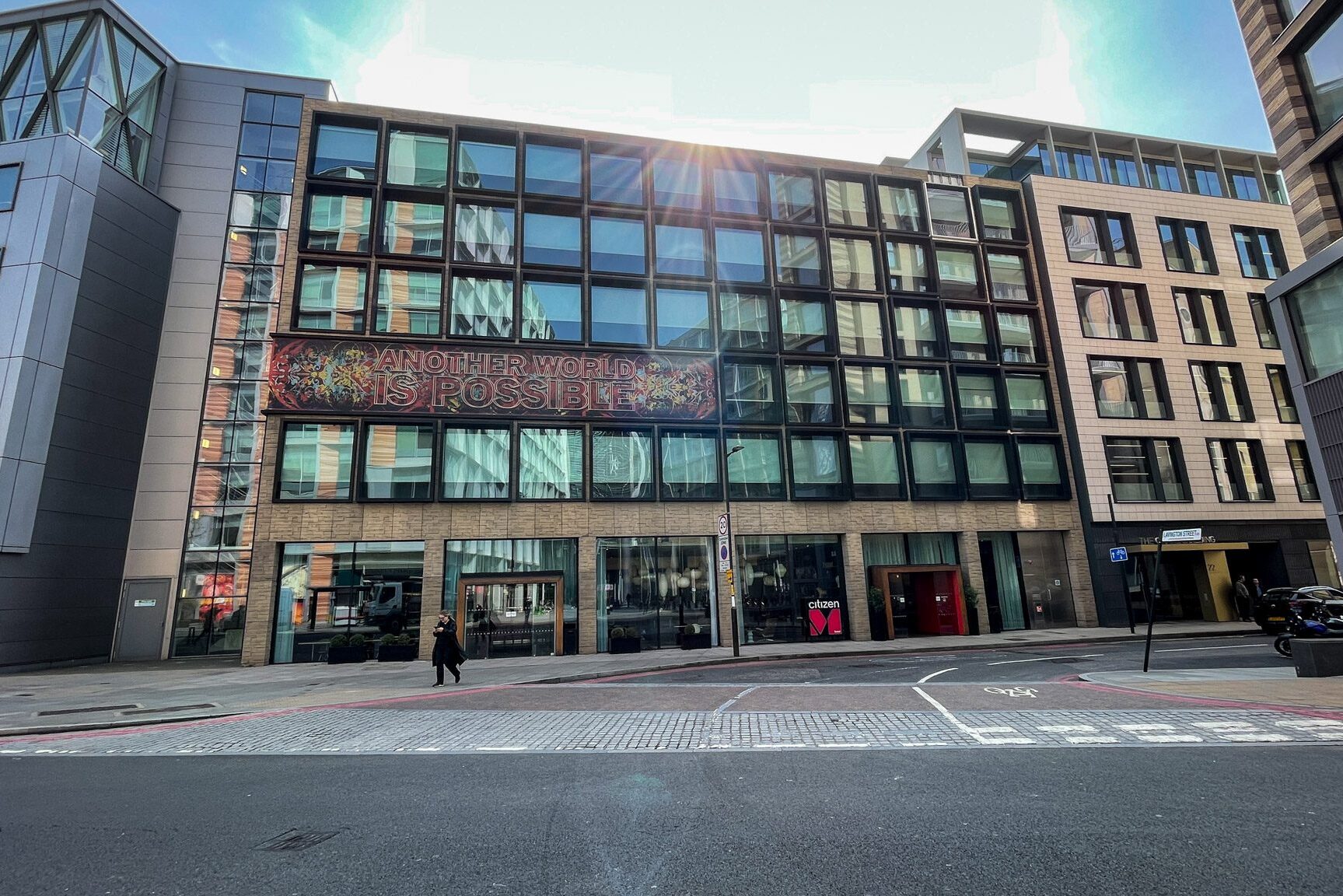
We have a deep love affair going on with CitizenM hotels, having stayed in multiple locations on different continents over the past several months (at the time of writing). Including four nights at the CitizenM Bankside to kick off our trip to London.
The experience at all of their hotels has been remarkably similar – almost like they designed it that way – and everything from check-in to check-out is seamless and well thought out in a way we didn’t think was possible for hotels. Plus, it’s surprisingly affordable!
Breaking from the mold of traditional hotels, CitizenM reimagined what the word “hotel” really means, and the definition they came up with takes everything we think of when we think of chain hotels – aging rooms (with iPod docks), ironing boards, unhelpful staff – and turns it on its head.
Here’s a relatively brief overview of why we love their hotels. For a more in-depth look at what staying at a CitizenM Hotel is like, read our review of their Seattle location.
It starts with booking. They have exactly one type of room – a compact room with a gigantic, comfortable king bed – so there’s no analysis paralysis around whether you want the standard, the standard-plus, or the plus-plus-standard room type.
Then comes check-in. Everything is done through screens in the lobby (though a helpful staff member will be right there to help iron out any issues or answer any questions), and you even get to select what side of the building and floor you want your room to be on.

What about the rooms? The rooms are designed for one thing, and they deliver that one thing flawlessly. That one thing? A great night of sleep. Blackout curtains, temperature control via iPad, and huge, comfortable beds are the name of the game. We usually don’t sleep well in hotels because of light, noise, and weird beds, but we sleep like babies with CitizenM. They even found a way to stop light coming in from under the door! A miracle!
Did we mention the gigantic, super comfortable bed?
The downside here is twofold. One, small rooms mean very little privacy, so these rooms are probably best for close friends and couples. Two, they only have one room configuration, so families who all want to stay in the same room probably should look elsewhere.
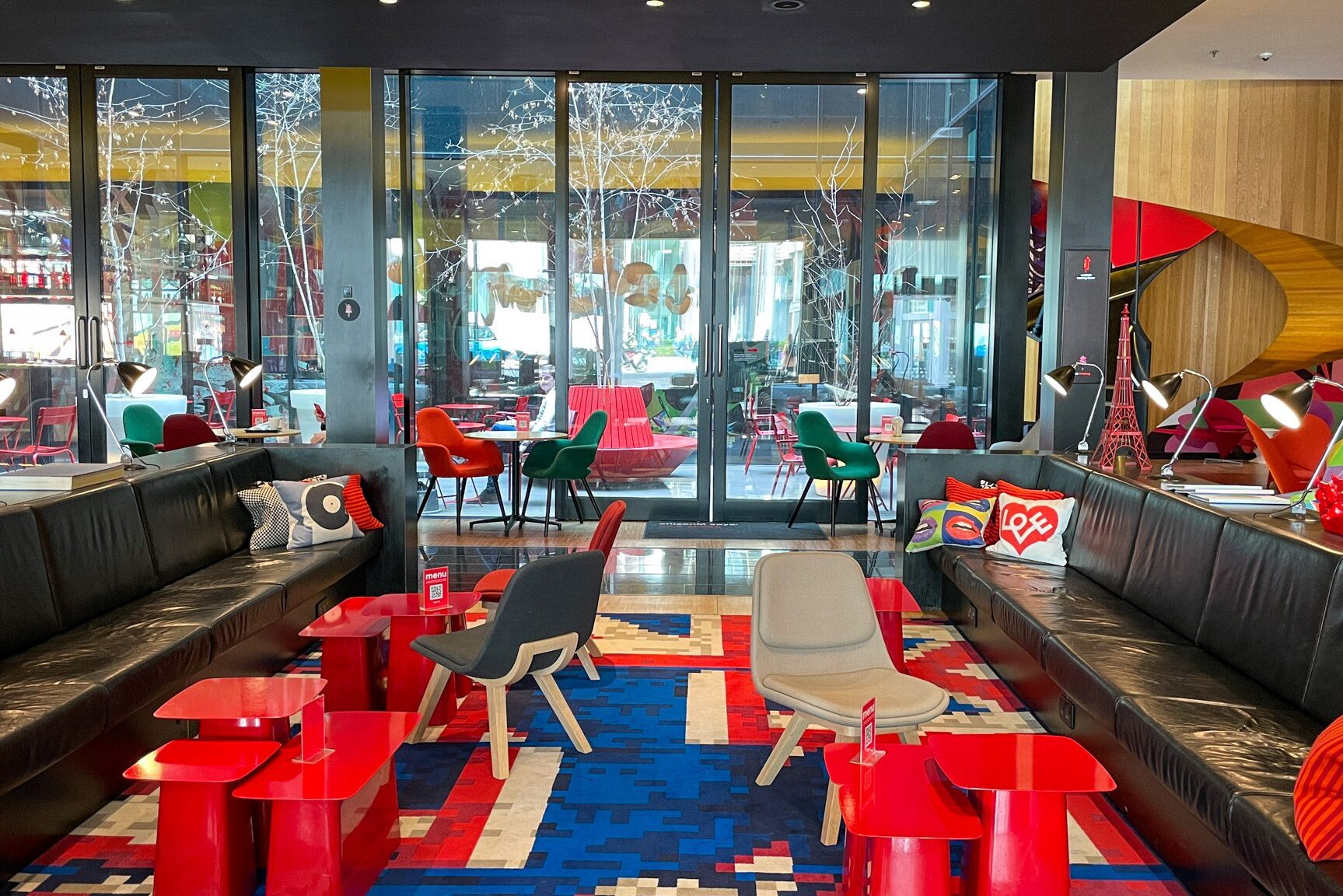
While the rooms are small, they have amazing common areas – like the huge, open lobby that they call the “living room,” which give you a place to hang out other than on the bed.
Sea Containers: A Splurge with Stunning River Views

If you’re looking for a splurge in London, Sea Containers is at the top of our list because of the incredible river views from some of their rooms (make sure to book a room with a river view!).
This hotel is right on the south bank of the Thames, and it’s a great location for exploring both sides of the river thanks to Blackfriars Bridge, which is right outside the doors of the hotel.
They’ve designed the hotel to feel like a 1920’s transatlantic cruise liner, which is a fun theme given the waterfront location. In the rooms, you’ll find huge windows, elegant black and white designs with pops of color, and incredible views of London’s skyline.
Standard rooms are more than 300 square feet – GIGANTIC! – and they have studios and suites with even more space. Some rooms even have balconies overlooking the Thames. There’s also a rooftop bar and restaurant with even better views of the London skyline.
This is not a budget stay, by any means, but if you’re looking for a splurge for a special occasion, this is our top pick in London.
Native Bankside: Stylish Apartments on Southbank
If you’re looking to stay in Southbank and want the extra level of space and comfort that comes with staying in an apartment, look at Native Bankside.
We considered this place, but couldn’t turn down our first love, CitizenM, so we saved Native for a trip down the road.
Like many of the serviced apartments popping up all over the world, Native is a company that is combining the convenience and service of staying in a hotel with the extra space and access to a kitchen that you get with an apartment. Plus, 24/7 reception means staff are always on hand to help (and more importantly, to give you a place to leave your bags!).
The building is a former tea warehouse in what used to be an industrial area, and they’ve meticulously restored it to bring it into the 21st Century.
To be honest, their smallest rooms aren’t much bigger than a hotel room, but they’re cleverly thought out with pop-out dining tables and a stovetop to give you more amenities than you get in a hotel. Somehow – and I’m still not sure how – they fit both a dishwasher AND a washing machine into a 300 square foot room. Mind blowing.
They also have bigger rooms – including studios, one, and two bedroom apartments – and the thing they do well is using space efficiently. All rooms have stovetops and ovens/microwaves. As you get up to the one bedroom apartments, you’ll get more space.
The location is right on the south side of Southwark Bridge, within five minutes of the excellent Borough Market, and a short walk from the City of London and St. Paul’s Cathedral.
Covent Garden: The Best Location for First Timers in London

As we spent time walking through London’s West End, we came to the conclusion that there are only certain parts of it that we’d really recommend.
The West End generally refers to the area east of Westminster and north of the Thames, just west of the border of the original City of London that dates back to Roman times. It includes sub-neighborhoods like Covent Garden, Holborn, and Soho.
It’s the main hub for entertainment – particularly theater – in London, and is home to multiple important cultural sights like the National Gallery and the British Museum. It’s also the place to be in London if you want to do some shopping, with all sorts of global brands vying for attention along the vast majority of streets in the West End.
Those qualities, along with its extremely convenient location and plethora of public transit connections, make it an excellent place to stay, particularly if it’s your first trip to London, or if you only have a day or two to explore the city.
You might have already guessed which area we’d choose within the West End based on the name of this section.
It’s Covent Garden. Though, we will say, we also like Holborn (the northeast section of the neighborhood), and will include a few places to stay in Holborn in the list below.
Covent Garden is the most charming piece of this part of the city, swapping the wide boulevards lined with designer stores that you’ll find in Soho for narrow cobblestone streets and winding alleyways. We think you’ll find that Covent Garden has much more character, and has all the benefits of staying smack dab in the middle of London.
Pros and Cons of Staying in Covent Garden
Pros:
- It’s charming. With cobblestone streets (that we couldn’t stop tripping over, for some reason) and a mix of architectural styles, this is the most charming part of touristy London, at least in our opinion.
- It’s walkable. If you stay here, you’ll have a bunch of the main sights in London on your doorstep – Leicester Square, Trafalgar Square, Big Ben and Westminster Abbey, and more. Plus, if you’re up for a bit of a walk, you’ll be within walking distance of Southbank, Mayfair, and Hyde Park too.
Cons:
- It doesn’t get much more expensive than Covent Garden. London is an expensive place to visit to begin with, and Covent Garden is perhaps the most expensive part of the city. There are a few more budget-friendly options, but it’s still not going to be cheap.
Covent Garden Highlights
Despite being a relatively small area, Covent Garden is packed with things to do, see, eat, and drink.
Seven Dials Market: In a city with a nearly unlimited selection of food markets, this one is up there at the top. Bonus: It’s open for lunch AND dinner, whereas many are just open for lunch. Don’t miss El Pollote for the guava-glazed chicken wings.

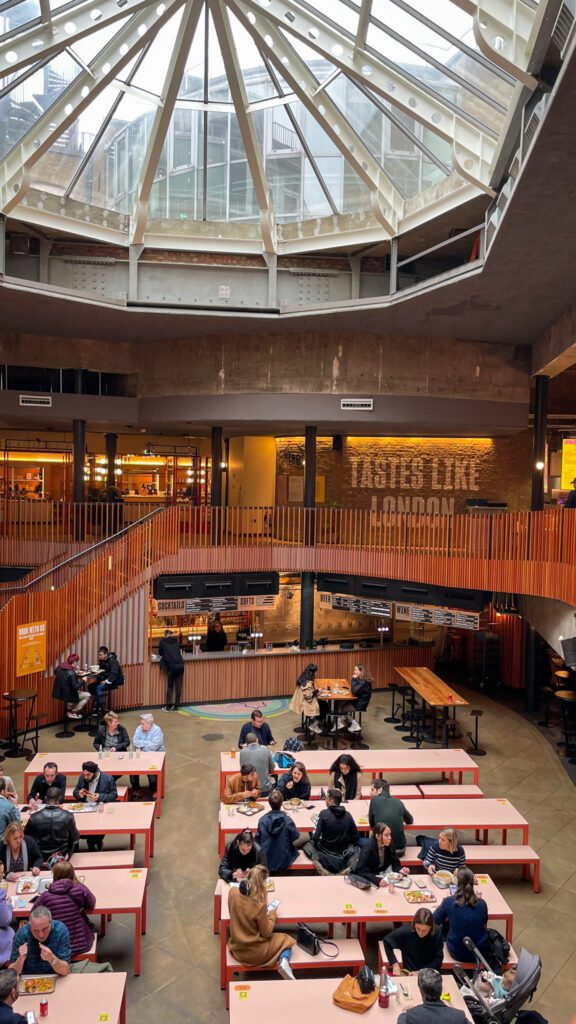
Chai Guys: Located in Seven Dials Market, this place deserves its own section. Their original location is at Spitalfields, which is where we first discovered them. Alysha is a HUGE fan of chai, so we basically split our time between hunting for the best coffee in London, and sipping all the different chai we could get our hands on. When you order chai at home in the US, it’s usually a chai latte, and it’s usually sickeningly sweet and not at all spicy. Not so in London, and particularly at Chai Guys! We loved their Kadak Chai, which is a little more creamy than the traditional Masala (which is also fantastic). Highly recommend!
Monmouth Coffee: One of the OG coffee shops in the city, this place is worth a visit for the breadth of different coffees. You can get an espresso-based drink (when in London, drink flat whites), or you can get their filter coffee, which rotates based on the season and what the staff are into at the moment. We like that they’ve completely abolished disposable takeaway cups, so get your coffee to drink there, or invest £5 in a reusable takeaway cup (which you get back when you return it).
The Apple Market & Jubilee Market: Right next door to each other, these are two cool covered markets right in the heart of Covent Garden. There’s a mix of temporary stalls and permanent shops to peruse, and every time we walked by there was a cornucopia of entertaining street performers set up around the market.
Trafalgar Square: Not sure if this is technically Covent Garden, but despite being a huge tourist attraction, this is the square or circus that is most worth visiting. There’s a giant obelisk featuring Admiral Nelson – a famous British navy officer who outwitted Napoleon, among many others – and a great view towards Big Ben. The National Portrait Gallery is also here, which is free to visit.
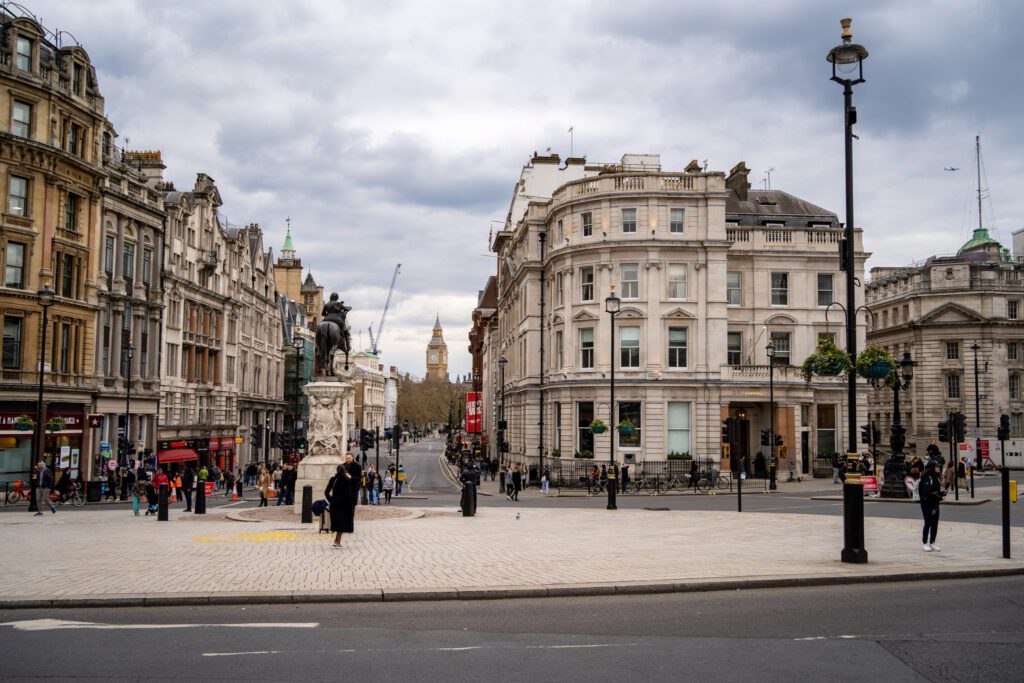
The Best Places to Stay in Covent Garden
Here are some places to stay in Covent Garden that caught our eye.
Page 8 Hotel: A Stylish Hotel in a Great Location
If we were choosing a place to stay in Covent Garden, Page8 would be our top pick in terms of hotels. It’s at the southwestern corner of the neighborhood, a few blocks from Trafalgar Square and all of the theater options nearby, and it’s modern, stylish, and in a great location.
Page Hotels (there are currently two of them at the time of writing, London and Hong Kong) are built for “Urban Explorers” in their own words. What, exactly, does that mean? Great question!
As two people who are probably right in the target demographic for this hotel, here’s our take.
Like many of our favorite hotels, they have a philosophy that combines comfortable, compact rooms with sprawling common spaces that are perfect for connecting with like minded travelers, or just reading a book and watching the world go by.
The rooms are about average size here, though they do have some bigger room options with more space to relax. It’s also worth noting that they have family rooms with two queen beds, if you’re traveling with a group who wants to all stay in the same room.
You’re not going to find all the bells and whistles in your room that you might get at a more traditional hotel, but they have included some of the most important things that we refuse to skimp on, like comfortable beds and soundproofed rooms.
They also have free tea and coffee in the room, which is usually something that gets cut, and we think the Marshall speakers are a fun, vintage touch.
As far as common spaces go, they’ve done a good job of designing them to be full of light and warmth, which makes it an inviting place to hang out rather than a place you’re trying to get out of as fast as possible to either get to your room, or out into the city.
There’s a coffee bar (of course there is) for a quick morning caffeine fix (if the in-room coffee isn’t what you’re looking for), and every surface in the common areas and rooms is full of a selection of coffee table books that will have you wishing you had better taste in coffee table books in your own home.
The Z Hotel Covent Garden: An Affordable Stay in London? Impossible!
Z Hotels is a chain of mid-range hotels in London (with some other locations in the UK) that brings a blend of style, affordability, and great locations to the table. With those three boxes checked, we think the Z Hotel Covent Garden would be a fantastic home base for exploring London.
However, there is an important caveat. In order to deliver both style AND affordability, you’re going to have to be okay with smaller rooms and fewer amenities than you might get at true luxury hotels (BYOFS – bring your own fluffy slippers). It’s similar to CitizenM – our favorite hotel chain in the world – in that regard.
You won’t have a phone, a safe, or a minibar in the room (which means no fridge). You will find comfortable beds and TVs with plenty of entertainment options, as well as air conditioning for those seven days a year where you might need it in London.
The rooms are small, but they’re extremely well thought out, with plenty of room for a couple to stay in without being overly cramped. They also have family rooms with multiple beds, but it’s worth noting that most rooms are only really designed for 1-2 people.
NoMad London: A Stylish Luxury Hotel in the Heart of the West End
NoMad Hotels are always stylish, and their (relatively new) hotel in London is no different. The building is historic, formerly housing the police station and the Bow Street Magistrates’ Court at points in history, and it has been meticulously transformed to blend history and modernity in every facet.
The hotel is just a couple of blocks away from the Covent Garden Tube stop (pro-tip: take the elevator from the platform rather than climbing 15 stories of stairs – trust us!), which means you’re both within walking distance of most of Westminster and the West End, and can easily hop on the Tube to get elsewhere.
Rooms are gigantic by London standards, with the smallest coming in at around 250 square feet and getting bigger from there. All rooms have some sort of seating area, although the more expensive, bigger rooms have a more robust place to hang out (other than the bed).
It’s certainly not cheap, but if you’re looking for a touch of luxury on your trip to London, the NoMad would be a great choice.
COVE Arne Street: Serviced Apartments, Perfect for Groups of All Sizes
We stayed with COVE at their location on Cannon Street in the City of London, and were super impressed from the beginning to end of our stay. We always prefer staying in apartments, but we avoid vacation rentals in cities if we can, and enjoy the convenience of 24 hour reception that hotels bring to the table.
COVE Arne Street is a similar experience to their other location where we stayed, but it’s right in the heart of Covent Garden, which is arguably a more charming and interesting location than the City of London.
Choose from one, two, and three bedroom apartments that can accommodate anywhere between 2 and 10 guests (if a few are cool with sleeping on the sofa bed).
The beds are comfortable (in our experiences), the kitchens are nice (and stocked with everything you need to cook, for the most part), and it’s a spacious and comfortable space to hang out in.
If you want the amenities of an apartment in London, this is the place we’d recommend (along with their other location in the City, which is where we stayed).
The City of London: Super Central and Well Connected (Where We Stayed)

This part of London is one huge contradiction in our minds. We spent the last four days of our stay here.
On one hand, this is the historic center of London, where the city of London was located back in Roman times (then it was known as Londinium), perched on the north bank of the Thames.
There’s a piece of the original wall still standing, and you can learn about London’s history at the excellent (and free!) Museum of London.
What is confusing to us is the fact that this is also the most modern part of London. The financial district, if you will, is located here, and is full of huge modern skyscrapers. Normally, when you hear “old town,” what comes to mind is charming narrow streets and older buildings. Not here!
Why, you ask? The answer is complex, but we learned at the aforementioned Museum of London that it was partially due to the fact that large swaths of the City of London have burned down over the past few centuries, starting with the London fire in the 17th Century that leveled three quarters of the city, and more recently the Blitz in World War 2, which also did significant damage to buildings in Central London.
Those disasters, similar to a forest fire, did two things.
First, they led to enormous human suffering (in the forest fire analogy, I guess it would be tree suffering) and led to the loss of many historic buildings that used to be there.
But you could certainly argue that London would not look the way it does today without them, because those events also set the stage for the modernization of London that we see today, similar to the way a forest fire often leads to a new wave of growth from the ashes.
Anyway, that’s enough about the City of London’s fascinating history, you’re probably wondering why we chose to include it here.
It makes this list because of the central location and excellent connections to the main sights in Central London. You’ll be walkable to Borough Market, Tower Bridge and the Tower of London, and Spitalfields and Brick Lane.
There are also multiple Tube lines running right through the neighborhood, along with a plethora of buses to take you anywhere else you might need to go.

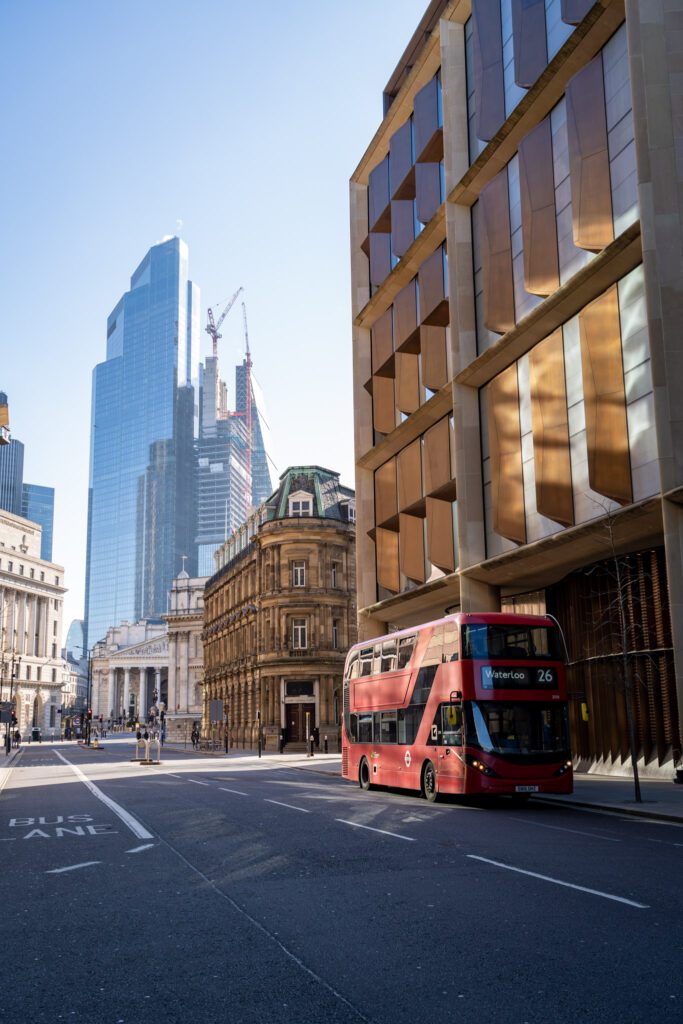
Pros and Cons of Staying in The City of London
Pros:
- The location is great. There’s a reason the Romans chose this as their city center. It’s close to the river, and in today’s London, it’s close to the Tower of London, St. Paul’s Cathedral, and Tower Bridge (among other places).
- The connections to the rest of the city. With multiple Tube lines running through the area (namely the Central and Circle/District lines), numerous bus lines that will take you in any direction, and access to the boats on the river, you’ve got plenty of options to get wherever you need to go that’s beyond your walking range. During rush hour – about 8:00-10:00 am and 4:00-6:00 pm, those options are INSANELY crowded though, be warned.
- The atmosphere on weekdays. On warm weekday afternoons, you’ll find scores of workers pouring out of their offices and heading to the local pub, where they stand outside on the curb with a cold beer and their friends (er, mates) and enjoy a pint or seven. Which is a fantastic atmosphere. Weekends, on the other hand…
Cons:
- It’s DEAD on the weekends. Because this area is mainly office buildings, it’s completely empty on the weekends. We don’t mind that at all, but it does mean that many of the coffee shops, restaurants, and pubs are closed on weekends (particularly Sundays), so you’ll need to head elsewhere.
City of London Highlights

St. Paul’s Cathedral: The biggest church in London, it’s well worth the price of admission for the climb up to the golden gallery waaaayyy up at the top of the dome, where you’ll have excellent views out over London. In addition, the First Duke of Wellington and Admiral Horatio Nelson (famous for outwitting Napoleon multiple times, among other naval adventures) are also buried in the crypt.
Rosslyn Coffee: One of my favorite coffee shops in London, Rosslyn is the product of an Irishman and an Australian’s vision for a coffee-shop-meets-Irish-pub. The people are warm and friendly and the coffee is great (and approachable – they’ve simplified the choices so that you aren’t paralyzed by choice).
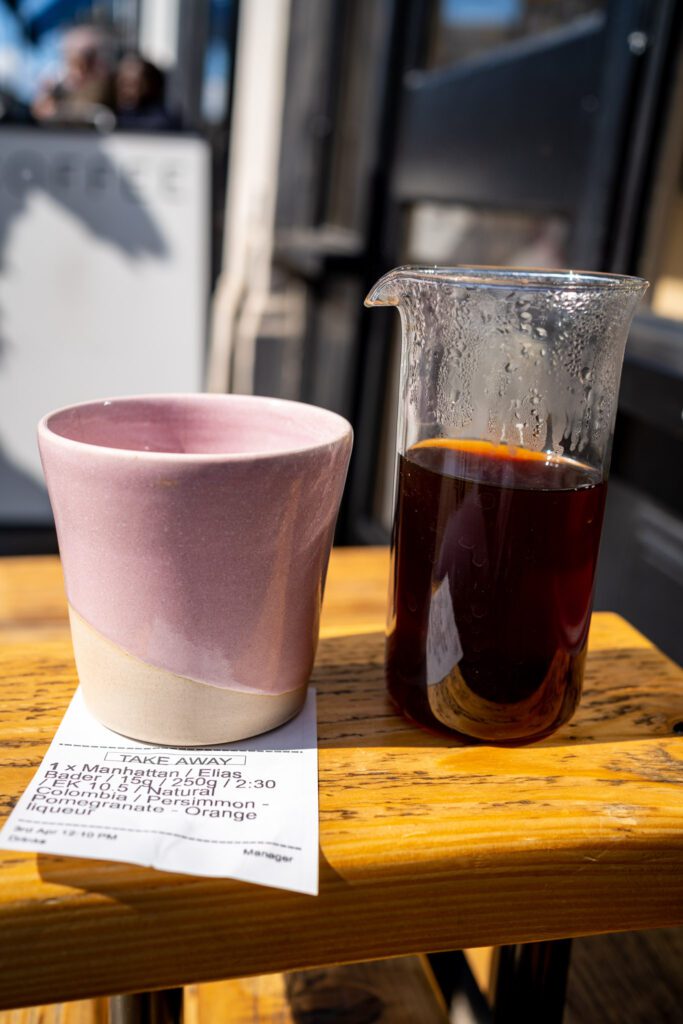
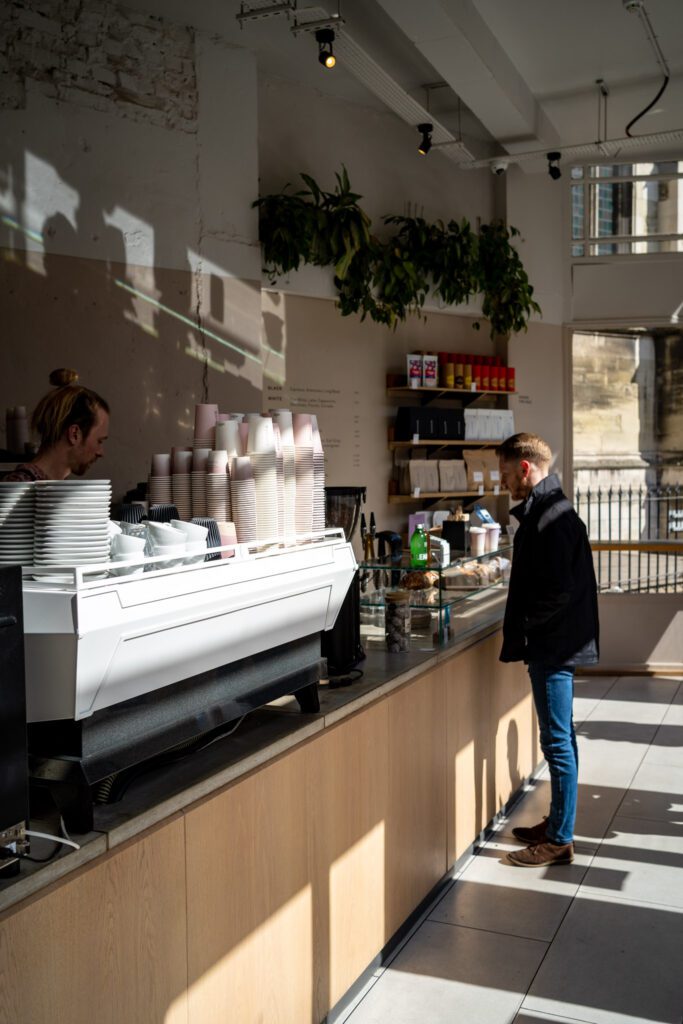
The Museum of London: We really enjoyed this relatively small museum, which is located next to the part of the Roman wall that is still standing. It gives you a nice overview of London’s often turbulent history that set the stage for the city to become one of the world’s preeminent cities (and one of the most cosmopolitan). It changed quite a few of our perceptions of London. For example, being from the United States, we never think of London (or the UK) as being oppressed by outside forces, but for the bulk of its history, London has had outsiders controlling its destiny until the last four or five centuries. It’s worth an hour or two of your time to get a baseline of understanding on your trip. Plus, it’s free!
The Tower of London: Definitely worth a visit, the Tower of London is where you’ll find the Crown Jewels and some excellent views of Southwark across the river. It was built as a defensive structure along the river, became a royal palace, was transformed into a bloody prison, and has since become a staple on basically any London itinerary.

The public rooftops: There are a bunch of public (and private) rooftop terraces and gardens in the City of London. We liked One New Change, which is probably the most famous of the bunch because of the excellent view of St. Paul’s Cathedral. Another great option is the Garden at 120.
The Best Places to Stay in the City of London
Here are some places to stay in the City of London that stood out to us.
CitizenM Tower of London: Our Favorite Hotel Chain in an Incredible Location

If you missed us waxing poetic about CitizenM in the Southbank section above, go read that for why CitizenM is our all time favorite hotel chain in the world.
We’ve stayed at multiple CitizenM properties around the world (including the one in Southbank), and they deliver an excellent night of sleep at an affordable price every single time.
Rather than talking about CitizenM’s offering, let’s focus on this particular hotel, which has some great features that actually take it a step above the usual CitizenM Hotel.
First is the location. It’s quite literally next door to the Tower of London, walkable to Tower Bridge and St. Paul’s Cathedral (among other things), and well connected via public transportation like buses and the Tube.
Second is the rooftop bar with views of the City of London and Tower of London. We meant to make it here based on the advice of the staff at the Southbank location, but didn’t quite make it happen.
Third is the views from some of the rooms. Whichever direction you’re looking in, you’re pretty much guaranteed to have a nice view from the external rooms, though the rooms overlooking the Tower and Tower Bridge are probably the best of the bunch.
CitizenM is always a great value – that’s their whole thing – and the extra touches at this particular location make it an excellent place to stay in London.
COVE Cannon Street: Stylish Apartments, Perfect Location (Where We Stayed)

We stayed here for our last few days in London, and were pleasantly surprised at how nice it was.
We always gravitate towards apartments when we’re traveling for two reasons.
First, Matt has Celiac Disease and needs to eat strictly gluten free, which means having access to a kitchen is almost essential (although London is packed full of amazing gluten free food, which you can read about in our gluten free guide to London).
Second, the extra space is nice when you’re doing work on the road (which we usually are). We can only take so much of working on the bed in a hotel room before it gets tiresome.
However, apartments (especially vacation rentals) have some serious downsides, like the lack of ability to leave bags if you arrive before check in, and the lack of onsite staff to help with issues that pop up. With COVE, you get the best of both worlds! They blend the convenience of staying in a hotel with the extra space and access to a kitchen that you get by staying in an apartment.
COVE Cannon Street has a 24 hour reception, so you can leave your bags when you arrive (a major pain point with vacation rentals!). Plus, we always enjoy talking to the friendly staff to get any recommendations or inside knowledge we should know about the area, and we spent ten minutes at check-in chatting with the extra friendly staff at the front desk here.
They have apartment configurations ranging from studios (we stayed in a “Superior Studio,” which was perfect), to one bedroom apartments that are all efficiently designed, with full kitchens (inclduding ovens and dishwashers) and washing machines in all units.
Bigger groups of 3-6 should look at their other location in Covent Garden for two and three bedroom options in a similarly great location.
Staying here also means you’re literally across the street from the best coffee shop in London – Rosslyn Coffee – where you can get your morning dose of caffeine before heading out. Plus, it’s just two blocks from St. Paul’s Cathedral!
Shoreditch: Best for Hipsters, Artists, and Nightlife
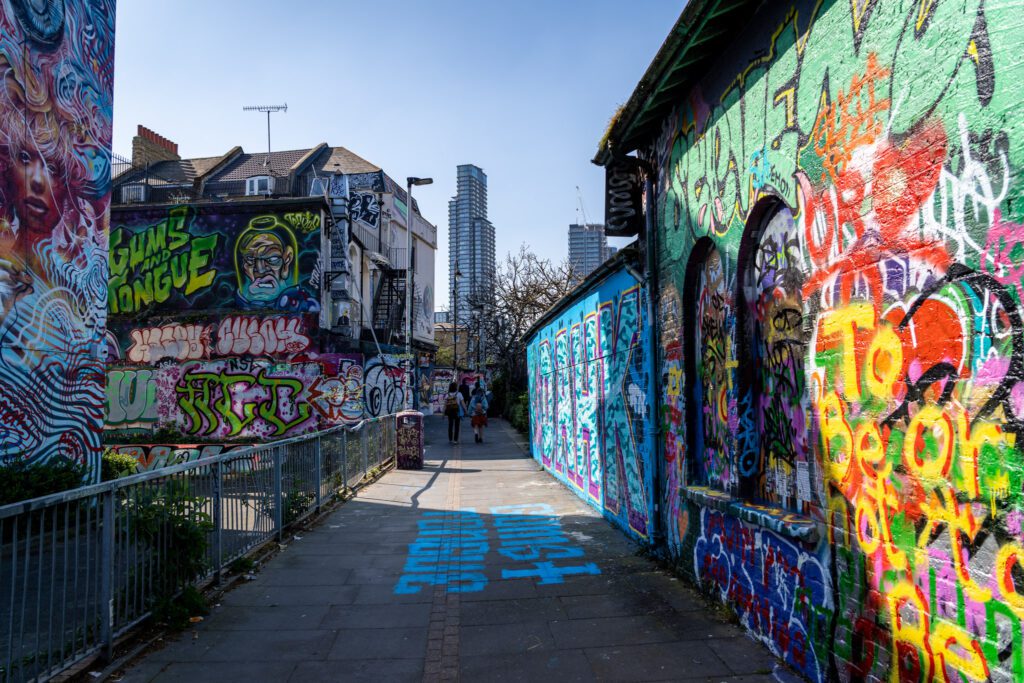
We’re not sure we’ve ever seen a higher concentration of vintage stores than we saw in Shoreditch. And that tells you a lot about this hip neighborhood in northeast London and the transformation it has undergone in the past decade or so.
At one point, Shoreditch was completely separate from the city of London, but over the years the borders of London have continually expanded, swallowing up former suburbs on its way to becoming the city it has become today.
Even the origin story of Shoreditch is a little counterculture. It became famous because in the 16th Century, some politicians got the idea that banning playhouses (and theaters) in London sounded like a good idea. Imagine what they’d think if they saw London today!
So, in order to meet the demand that certainly hadn’t evaporated despite the ban, new theaters were built in places like Shoreditch and Southwark, which at the time were outside of the city limits, and thus its jurisdiction. In the 19th and early 20th centuries, it was a legitimate rival to the West End as the center of London’s arts scene.
After the second world war, during which large swaths of the neighborhood were demolished – including a lot of housing – the reconstruction process took a little longer than other parts of London. To make matters worse, globalization led to the relocation of many of the factories in the area. That left a lot of industrial buildings that were empty, which is evident today as the whole area has taken on a very “industrial-chic” vibe.
Since then, the story of Shoreditch is similar to many other highly gentrified areas in major cities around the world.
First the artists moved in, creating a demand for businesses that those artists liked, and finally ending with astronomical housing prices that drove out many of the original residents (and those artists, too) and brought in a more wealthy contingent, who in turn brought a different set of businesses to cater to their different needs.
We’ve seen that story in cities that we’ve lived in, like the Mission District in San Francisco, or Capitol Hill in Seattle.
In our minds, the story of Shoreditch feels very similar to those stories, and while we think there’s a lot of cool places to see, eat, and drink in the area, it’s worth keeping in mind the context behind how those places came to be. If you want to know more about its history and gentrification, read this.
Note: We’re going to combine a few different areas, including Spitalfields and Shoreditch, into this section. Technically, they’re distinct neighborhoods, but we don’t think they are distinct enough to demand their own sections.

Pros and Cons of Staying in Shoreditch
Pros:
- It’s hip. We’ve never seen so many vintage stores as we did on Brick Lane. And they have an entire store dedicated to plant based cheese (with an excellent name, we might add – La Fauxmagerie).
- The weekend markets are awesome. There are two excellent markets in this area, and we went to both twice because we enjoyed them so much. First is Spitalfields Market, which is open everyday but is at its best on Saturdays at the arts market, when it’s filled with stalls selling all sorts of fun stuff (there’s food, arts and crafts, and more). Second is the Sunday Upmarket on Brick Lane, which has an incredible food section with stalls selling food from all corners of the globe. Despite the name, it’s open both Saturday and Sunday.
- The food and drink scene is great. Even excluding those two markets, the food and drink scene in this area is fantastic. Dishoom (a popular Indian restaurant chain) has a location up here, and there are so many bars which makes this one of the better places in London to head to after dark.
Cons:
- It’s busy, loud, and boisterous. This is not an “off-the-beaten-path” neighborhood. It’s packed full of people at most hours of the day. Due to the nightlife, it can also be loud after dark.
- Gentrification. While the ship has largely already sailed on the gentrification of Shoreditch, it’s worth keeping in mind as you decide where to stay. A few decades ago, this was a relatively poor part of London that has since seen skyrocketing costs of housing due to its popularity with tourists and Londoners, forcing many of the original residents to relocate.
Shoreditch Highlights
Sunday Upmarket: Right on Brick Lane, this market is kind of two separate parts. There’s a huge vintage market, which isn’t really our vibe but was very, very busy. And there’s a food market, which is very much our vibe. If you’re into chai (or if you’re not, honestly), don’t miss Chai Baba, which Alysha demanded a return trip to on our last days in London. You’ll find food from basically everywhere in the world at the food portion here, which we loved.
Spitalfields Market: Just south of Shoreditch and a couple of blocks off of Brick Lane, this is the place to be on Saturdays. The interior of the huge open hall is full of temporary stands, selling everything from pop up cards (which we enjoyed and bought multiple of to send home), to arepas and bao buns. There’s an excellent selection of food and drinks (we like Guasa for arepas and Chai Guys for chai), and it’s worth spending some time wandering through the stalls – you never know what you might stumble across!
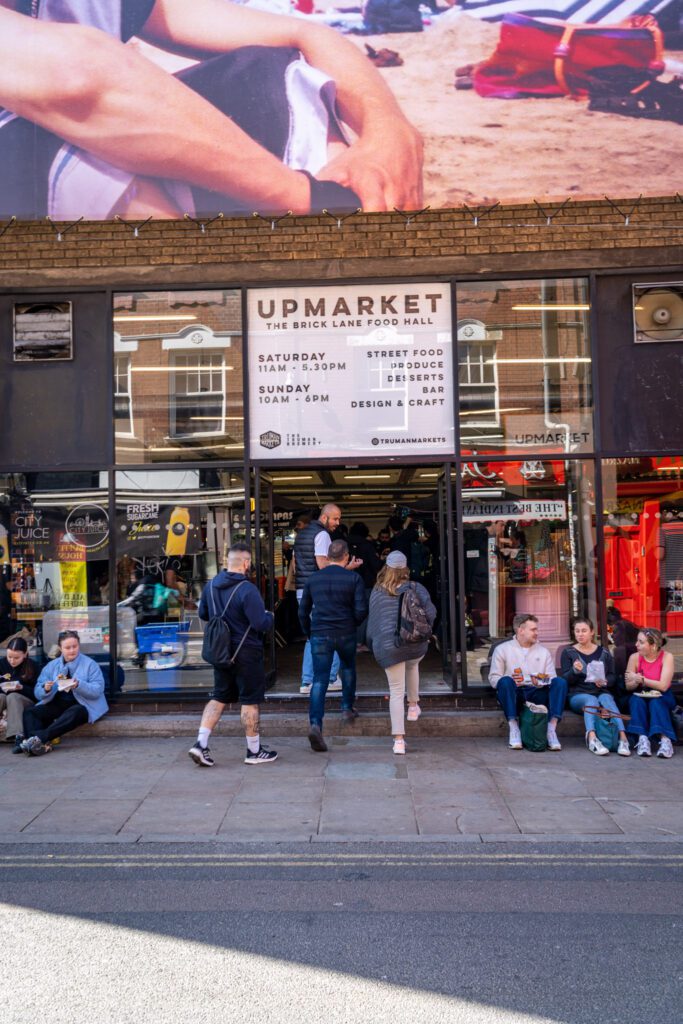

Origin Coffee: One of my favorite coffee shops in London (though they’re from Cornwall in southwest England), they have talented baristas and excellent coffees that they source directly from farmers, who they spend a lot of time and effort building long term relationships with.
The Columbia Road Flower Market: A cornucopia of flowers of all colors, shapes, and sizes on display just northeast of Shoreditch. It gets PACKED, so try to go early (plus you’ll have the best selection if you’re actually buying flowers). It’s on Sundays 8:00 am to 2:00 pm.
All the bars: There’s an endless number of hip cocktail bars in Shoreditch and around it, as you might expect. The Cocktail Trading Co for speakeasy vibes. Bounce for boozy ping pong. Junkyard Golf for mini golf in a fun environment (yes, with booze).
Camden: An Offbeat & Hip Place to Stay
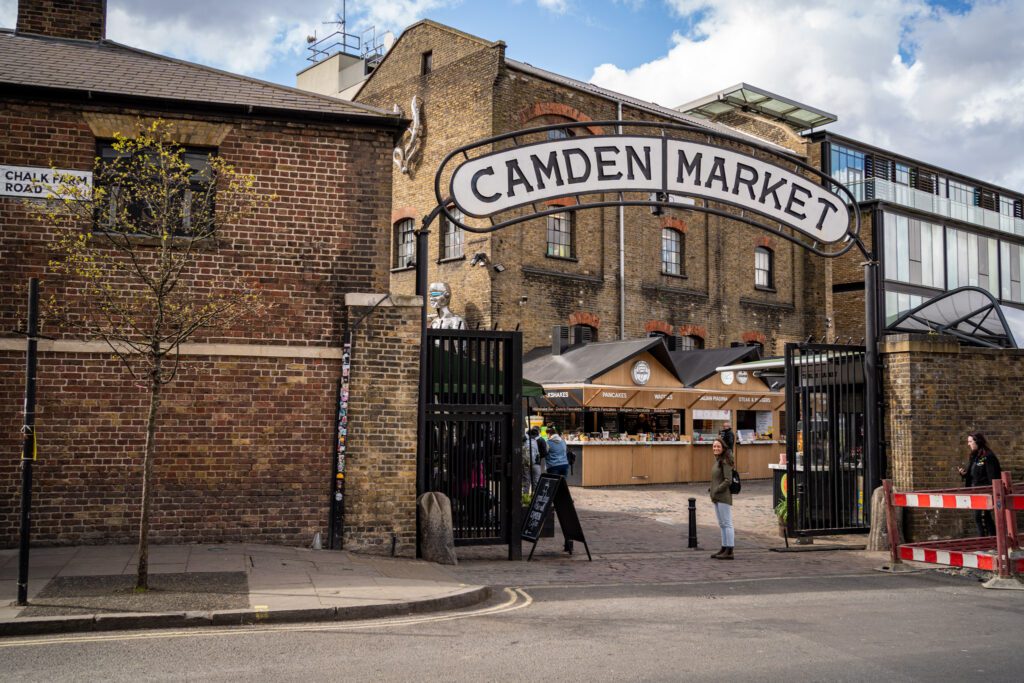
As we mentioned above, we split our 12 day trip into three blocks of four days each to experience a few different areas and have multiple home bases for exploring London since it’s so big.
Camden was our middle four days, and was easily the furthest from Central London we stayed. As we were walking along the Regent’s Canal on our second-to-last day in Camden, Alysha turned to me and said “this part has really felt like a completely different trip” (than the first four days in Southbank).
And I have to say, I completely agree.
I will also say that Camden completely broke from our expectations. We went into it thinking it was going to be a charming, suburb-y, more low key part of London. We were basically zero for three on those three things.
It’s definitely residential, and we walked by several different schools around pick up or dropoff time, when hundreds of parents were picking up kids from school (side note: is there anything cuter than a young kid with a British accent?).
It’s also very hip and artsy – lots of tattoo parlors, vintage shopping, and the always bustling Camden Market – and it has long been seen as one of the punk, alternative, counter culture parts of the city. Now, Shoreditch has kind of taken the mantle of the hipster part of London, but Camden is still somewhere on that list of hip neighborhoods.
Aside from Camden Market, which is probably the second most famous market collection in London (after Borough Market), there are a few other spots that we’d recommend in the neighborhood, and it’s right adjacent to Regent’s Park and Regent’s Canal runs right through the middle of the neighborhood.
It’s a little further out, though it’s well connected to the rest of the city through the Tube and several bus lines that will get you down to the heart of Central London (read: the touristy part) in about 20 minutes or so.

Pros and Cons of Staying in Camden
Pros:
- It’s a fun place to hang out. Between the park, Primrose Hill, and the market, this is a really fun neighborhood. Outside of those things, there are some good coffee shops, bars and pubs, and other gems that most tourists in London probably never get to see.
- It’s more affordable than Central London. It’s still not cheap by the standards of places like Italy, Spain, and Portugal, but it’s certainly cheaper than staying right in the middle of the West End.
- It’s well connected. Between the Northern line running through the neighborhood which takes you right into Central London, and the fact that you’re within walking distance of King’s Cross, you’ll be able to get everywhere you need to go relatively easily.
Cons:
- It’s further out and less convenient. Despite being well-connected, it’s still going to take a little bit of extra time to get to places like Tower Bridge and St. Paul’s Cathedral (plan on 25-30 minutes). If you have a short trip or it’s your first time in London, this might not be the best choice for you.
- There aren’t that many places to stay. Because it’s more residential, there’s really not that many hotels (especially right in the heart of Camden near the market).
Camden Highlights
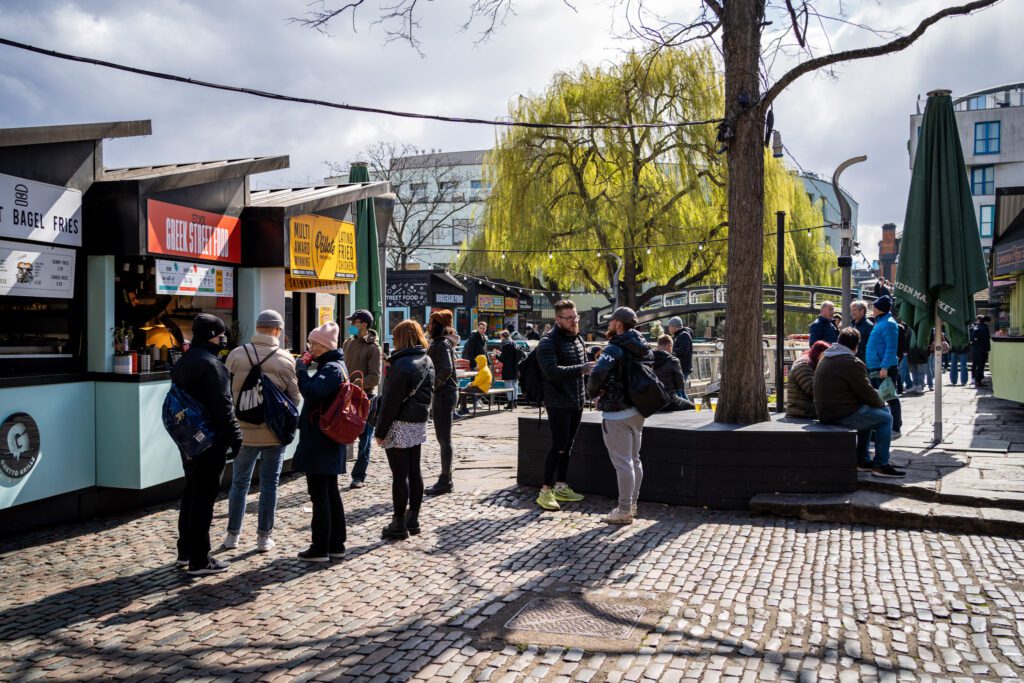
Let’s start with the obvious, Camden Market.
There are a few different parts of the market, and we’re going to lump them all together into one because they’re all within just a few blocks of each other. Here are some spots we liked and think you will too.
- Maize Blaze: A contemporary take on Colombian food (we spent six weeks in Colombia, and absolutely LOVED it), they have a limited menu available at the stall here that has bowls with various toppings. If you are looking for things like arepas and fried plantains with a sweet chili sauce, you can find them at their kitchen just a few blocks away (you’ll have to order online for pickup).
- Arepazo / Arepa Venezuelan Kitchen: To be honest, I don’t know what the name of this stand is. But I do know that it’s the place to get arepas at Camden Market. The pabellon, a pulled beef, was some of the best we had in London, and the vibes at the stand with the blasting music and dancing chef were awesome.
- Kolkati: Not gluten free, but Alysha saw it at Broadway Market (another market worth visiting) and decided she had to have it. So she finally got it here at Camden Market. They make kati rolls, which are a street food staple of Kolkata that consists of fillings (either meat and accouterments or paneer) wrapped in bread.
- Pamban Chai & Coffee House: If you like chai (like Alysha does), you shouldn’t miss this place. Their rose chai was Alysha’s favorite chai in London, and we drank A LOT of chai while we were in town. You can get a flight to try multiple of their chai offerings!
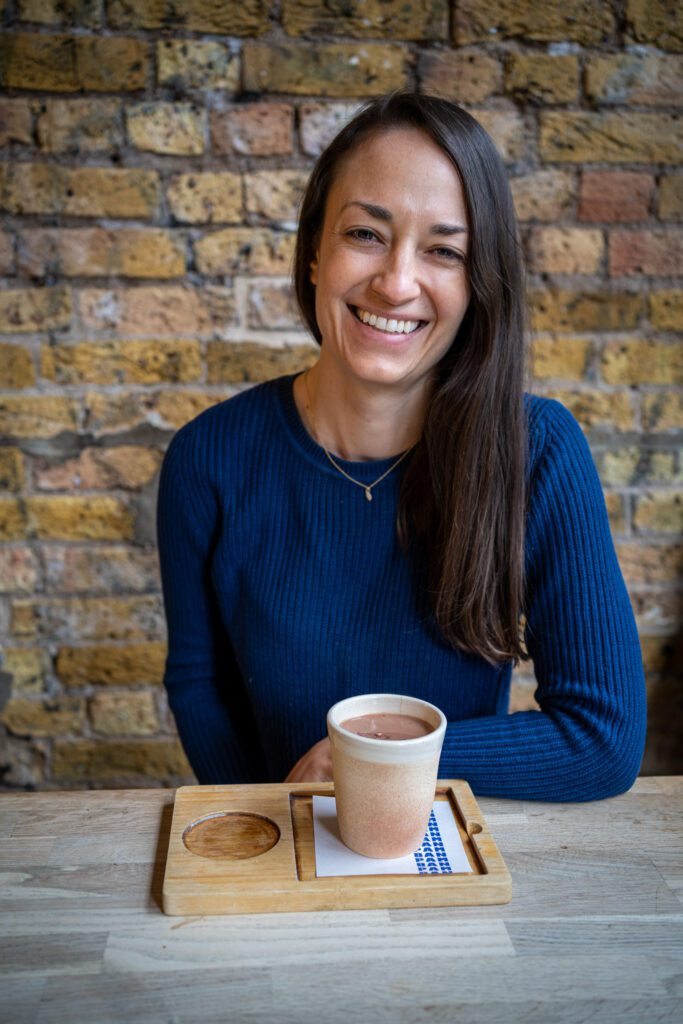
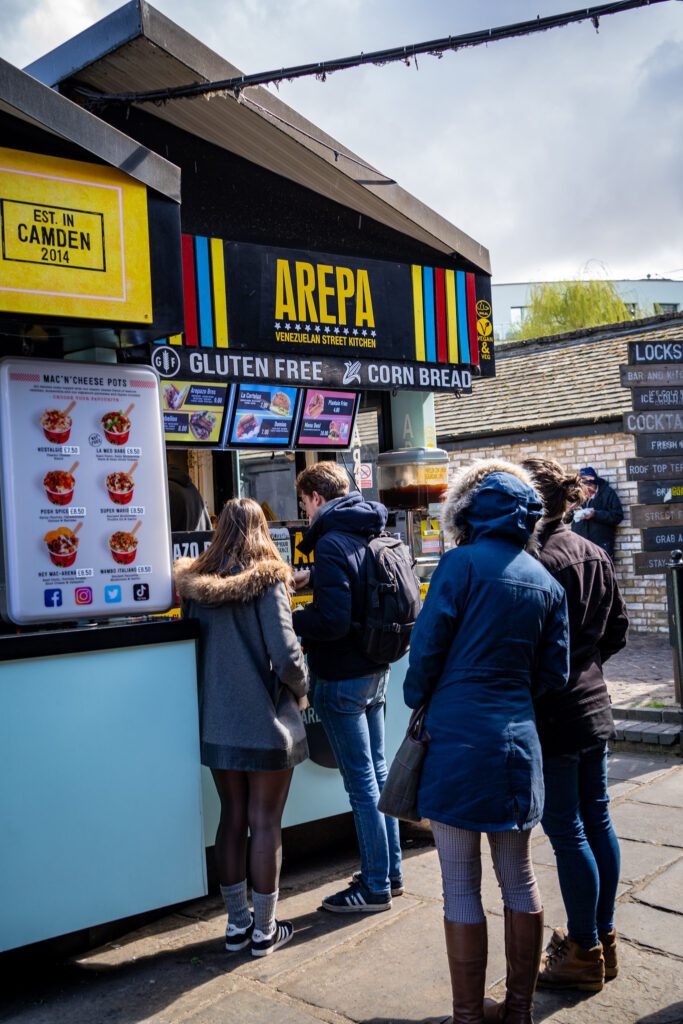
Beyond the market (really, markets), here are a few spots in Camden that we enjoyed.
Regent’s Park / Regent’s Canal: The huge park just west of Camden Town, and the canal that runs along its northern border, are a lovely place to spend part of a sunny afternoon up north. We walked all the way from Notting Hill along the canal back to Camden, and it was a nice journey (particularly through Little Venice). At one point, as we got closer to Camden, we realized we were walking across the water from the London Zoo (which is in the park), and started seeing warthogs and African hunting dogs across the way.
Primrose Hill: A nice neighborhood just northwest of the center of Camden, this is the place to go for great views of the London Skyline from the top of the hill.
Hackney / Bethnal Green: Low Key + Local Vibes = LOVE

We came out to East London twice for the amazing Broadway Market (go on Saturday for an excellent array of street food!), and walked away on our second trip deciding that, if we ever move to London, this is where we’d want to live.
Why?
First of all, Broadway Market is truly amazing. It’s a little far out for most people to get to on a day or two in London, but if you like street food and farmers markets, it’s worth the relatively short journey.
Second, it’s actually not very far away from the main tourist sights in Central London (and even closer to hip Shoreditch). There are a bunch of buses running directly downtown, and Bethnal Green Station connects you to the Underground to get around that way, if you’d prefer.
It has the right balance of residential nature, which means it’s relatively quiet, and nice strips of action lined with bars, coffee shops, boutiques, and restaurants.
And did we mention Broadway Market?
That being said, if it’s your first time in London and you’re wanting to hop around to all the touristy sights near the river, this probably isn’t the right place to stay for you.
Pros and Cons of Staying in Hackney / Bethnal Green
Pros:
- It’s low key and quiet. If you’re looking for a less hectic experience than staying in bustling central London, this is a good spot for you. It’s more residential, and though tourists occasionally amble up here (like us), the crowd skews heavily towards Londoners.
- It’s relatively affordable. For what you’re getting at the two places below (spoiler: there’s not that many places to stay, which is a con), it’s relatively affordable compared to more central areas in London.
Cons:
- It’s further out. If you’re wondering where to stay for your first time in London, this probably isn’t it. It’s going to take you 20-30 minutes to get to places like the City of London and the West End, which isn’t a deal breaker, but also isn’t ideal if you’re going to be spending most of your time down there.
- There’s only a couple of places to stay. Since it’s significantly more residential – almost like a suburb within the city – there’s really only two places to stay in the area. Both are surprisingly nice considering the location, but you won’t have as many choices as other neighborhoods in London.
Neighborhood Highlights
Broadway Market is our number one highlight here, but there are some other spots that are absolutely worth checking out.
Paradox Coffee: One of my favorites, this tiny coffee shop has a wide array of beans from roasters in the UK and in Europe. They have a few different options in terms of filter coffees, and a guest espresso if you’re looking for something a little wilder and more exciting than their house espresso. And they brew everything meticulously – both cups of coffee (one flat white, one filter) I had here were outstanding. Ozone Coffee, which is south of the market, is also worth visiting.
Columbia Road Flower Market: On Sundays, Columbia Road turns into THE place to be in London. The street, which is lined with shops, bars, and restaurants on one side, adds a lineup of stands that stretches several blocks who are all selling farm-fresh flowers of all different colors and varieties. It’s a zoo, but it’s worth visiting. You can walk from here to Broadway Market too.

I really appreciated this. I’m going back (from Australia) to the UK to live for a couple of years and trying to decide which area would suit. I previously lived in Kensington which is lovely although very expensive now.
Shoreditch and Camden look rather interesting. I look forward to checking out the cafes, restaurants and vintage stores you recommended. Cheers 🙂
Shoreditch and Camden are both great, especially the markets that exist in both of them. We’d eat at Camden Market everyday if we lived there (plus Regent’s Park is amazing, too). Cheers!